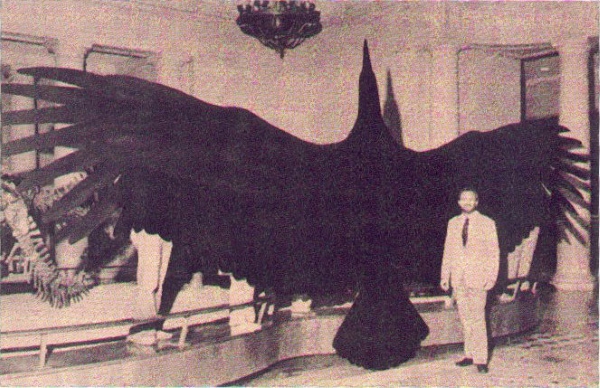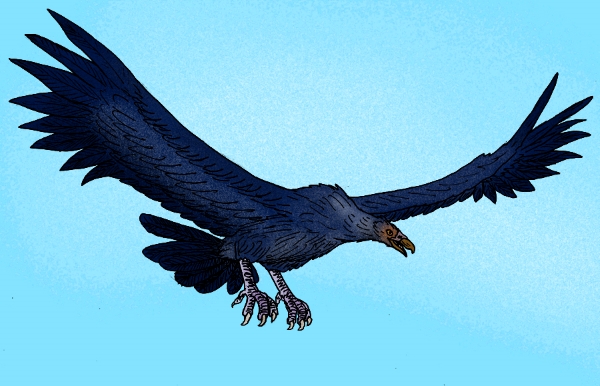
The Argentavis is one of the largest birds to ever roam the skies. Its scientific name, Argentavis magnificens literally means “magnificent Argentine bird” and it is named like this because it used to live in today’s Argentina.
Argentavis is a member of the extinct bird family Teratornithidae, a predatory group of birds related to storks and vultures.
About the size of a small glider, a perched specimen stood over 1.5 metres tall, weighed up to 70 kilograms, and stretched 3.35 metres from the tip of its bill to the end of its tail. Its fossil remains were discovered in Argentina in 1979 and indicated that this colossal bird seldom engaged in flapping flight, instead preferring to soar with the help of constant winds in the open grassland region where it lived.
They weren’t the largest birds, though. That honor goes to the Pelagornis sandersi, a bird that had a wingspan of 6.1 – 7.5 meters.
But the Argentavis was nonetheless magnificent! For a bird of its size, flying was not an easy feat, especially taking off could have proved difficult.
Reproduction and lifespan
Although there is no certain data about this aspect, but it is believed that the argentavis lived a long life, mainly due to its large size and the lack of a predator. It is believed they could have reached between 50 and 100 years.
Its reproduction habits seem to support the idea that it lived a long life. The argentavis laid one or two eggs weighing about 1 kg each every two years. The young argentavis was independent after about 16 months but fully mature only about 12 years.

What Did Argentavis Eat
Although it is uncertain what exactly did the argentavis feed on, it was certainly a carnivore. However, due to its enormous size, it is believed that it was not an active predator.
Paleontologists reconstructing the bird’s ecology speculate that, among other culinary habits, Argentavis magnificens may have been a scavenger. Due to its sheer size, it could have driven away most other mammals from their food and scavenging would have required less energy expenditure than active hunting.
But the argentavis was capable of hunting for its prey as well. When it localized a prey, it would dive from above and grab it without landing. Its body structure suggests that it swallowed prey without tearing apart their flesh.
It is uncertain why exactly did the argentavis go extinct, but it is believed that it is correlated with the extinction of some of the mammals it fed on. It went extinct around 6 million years ago.
Argentavis Facts
- Although very few things are certain about this magnificent bird, below we compiled a list of probable facts about it.
- The argentavis had a maximum wingspan of 7.6 meters (25 foot)
- It probably weighed up to 70 kg (155 pounds)
- Its habitat was in South America, fossils have been found mainly in today’s Argentina, hence the name.
- It lived up until six million years ago.
- Its diet consisted mainly of meat and most probably it was a scavenger.
- It flew like a glider.
- It laid one or two eggs every two years and cared for their small ones until they were at least 18 months old.
- It probably did not have any predator to worry about.
- The bird that they most likely resemble is the Andean Condor.
- The name “Argentavis” comes from the merging of two Greek words and mean “Argentinian bird”.
- It did not tear its food apart but probably swallowed its prey whole.
- It flew at a speed of about 40 km/h (25 mph).
- A single bird probably had a territory of 500 square kilometers where it searched for its food.
- They lived long lives, as they were fully mature only when they were around 12 years old. An argentavis could have even reached the age of 100 years!
- The cause of their extinction is not well known.


